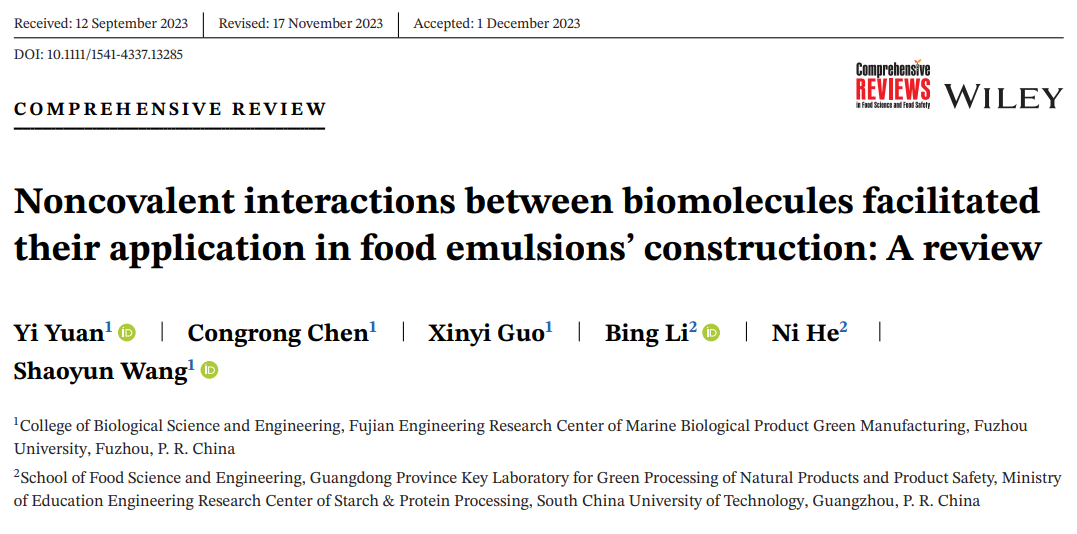福州大學(xué)汪少蕓教授、袁毅副教授發(fā)表頂刊綜述:生物分子間的非共價(jià)相互作用促進(jìn)它們在食品乳液構(gòu)建中的應(yīng)用
2023-12-20作者:來源:責(zé)任編輯:食品界
字體A+AA-
由于生物分子具有無毒、無害、可食用和生物相容性等優(yōu)點(diǎn),在食品乳液生產(chǎn)中使用蛋白質(zhì)、多糖、皂苷和磷脂等生物分子代替合成乳化劑引起了食品科學(xué)家的極大興趣。然而,使用單一生物分子并不總能滿足食品乳液應(yīng)用的實(shí)際需求。因此,生物分子通常需要修飾才能獲得理想的界面特性。其中,生物分子之間的非共價(jià)相互作用代表了一種很有前途的物理修飾方法,可以調(diào)節(jié)其界面性質(zhì),而不會引起與新化學(xué)鍵形成相關(guān)的健康風(fēng)險(xiǎn)。靜電相互作用、疏水相互作用和氫鍵是常見的非共價(jià)相互作用,可促進(jìn)生物分子在食品乳液中的有效應(yīng)用。這些相互作用對生物分子基食品乳液的物理穩(wěn)定性、氧化穩(wěn)定性、消化率、遞送特性、響應(yīng)靈敏度和可印刷性產(chǎn)生了積極影響。然而,利用生物分子之間的非共價(jià)相互作用來促進(jìn)它們在食品乳液中的應(yīng)用仍然存在需要進(jìn)一步改進(jìn)的局限性。
福州大學(xué)汪少蕓教授、袁毅副教授等人在Comprehensive Reviews in Food Science and Food Safety 發(fā)表了標(biāo)題為“Noncovalent interactions between biomolecules facilitated their application in food emulsions’ construction: A review”的文章,綜述了常見的生物分子乳化劑、生物分子間非共價(jià)相互作用對不同生物分子基乳液構(gòu)建的促進(jìn)作用和對乳液性能的積極影響,以及它們在生物分子乳液構(gòu)建中的局限性和前景。總之,未來食品乳液的設(shè)計(jì)和開發(fā)將越來越依賴于生物分子之間的非共價(jià)相互作用。然而,為了充分利用這些相互作用來構(gòu)建基于生物分子的乳液,還需要投入更多的工作。

汪少蕓教授,2006—2009年在美國威斯康星大學(xué)和美國加州大學(xué)戴維斯分校從事博士后研究,入選全國三八紅旗手、國家“萬人計(jì)劃”科技創(chuàng)新領(lǐng)軍人才、科技部中青年科技創(chuàng)新領(lǐng)軍人才、省A類高層次人才、省高層次創(chuàng)新人才、省科技創(chuàng)新領(lǐng)軍人才。擔(dān)任國家食品科學(xué)與工程“一流專業(yè)”負(fù)責(zé)人、省食品與生物工程“一流學(xué)科”帶頭人、省食品科學(xué)重點(diǎn)學(xué)科帶頭人、省海洋功能制品綠色制造“2011協(xié)同創(chuàng)新中心”主任、省海洋生物資源行業(yè)技術(shù)基地主任。擔(dān)任Food Science of Animal Products科學(xué)主編,Food Science and Human Wellness、Journal of Future Foods、Hans Journal of Food and Nutrition Science、《食品科學(xué)》和《食品工業(yè)科技》編委;擔(dān)任中國食品科技學(xué)會理事會理事、福建省食品科技學(xué)會副理事長、《中外食品技術(shù)》首批翻譯專家。主持承擔(dān)省部級以上項(xiàng)目30余項(xiàng)。編寫著作6 部,獲授權(quán)發(fā)明專利53 件,發(fā)表學(xué)術(shù)論文230 篇,其中被SCI/EI收錄180余篇,多篇論文獲中國食品學(xué)會創(chuàng)新科技論文獎和福建省自然科學(xué)優(yōu)秀論文一等獎。主持成果獲國際食品功能因子(ICoFF)學(xué)術(shù)大會獎、中國產(chǎn)學(xué)研合作創(chuàng)新成果一等獎、全國食品產(chǎn)學(xué)研創(chuàng)新發(fā)展優(yōu)秀科研成果獎一等獎、福建省科技進(jìn)步一等獎、中國石油和化學(xué)工業(yè)聯(lián)合會科技進(jìn)步一等獎、福建省自然科學(xué)二等獎、福建省科技進(jìn)步二等獎;獲評中國食品科技學(xué)會科技創(chuàng)新-杰出青年、寶鋼優(yōu)秀教師、盧嘉錫優(yōu)秀導(dǎo)師、福建省優(yōu)秀教師、福建省優(yōu)秀科技工作者。Noncovalent interactions between biomolecules facilitated their application in food emulsions' construction: A review
Yi Yuan1, Congrong Chen1, Xinyi Guo1, Bing Li2, Ni He2, Shaoyun Wang11College of Biological Science and Engineering, Fujian Engineering Research Center of Marine Biological Product Green Manufacturing, FuzhouUniversity, Fuzhou, P. R. China
2School of Food Science and Engineering, Guangdong Province Key Laboratory for Green Processing of Natural Products and Product Safety, Ministryof Education Engineering Research Center of Starch & Protein Processing, South China University of Technology, Guangzhou, P. R. ChinaAbstract:
The use of biomolecules, such as proteins, polysaccharides, saponins, and phospholipids, instead of synthetic emulsifiers in food emulsion creation has generated significant interest among food scientists due to their advantages of being nontoxic, harmless, edible, and biocompatible. However, using a single biomolecule may not always meet practical needs for food emulsion applications. Therefore, biomolecules often require modification to achieve ideal interfacial properties. Among them, noncovalent interactions between biomolecules represent a promising physical modification method to modulate their interfacial properties without causing the health risks associated with forming new chemical bonds. Electrostatic interactions, hydrophobic interactions, and hydrogen bonding are examples of noncovalent interactions that facilitate biomolecules' effective applications in food emulsions. These interactions positively impact the physical stability, oxidative stability, digestibility, delivery characteristics, response sensitivity, and printability of biomolecule-based food emulsions. Nevertheless, using noncovalent interactions between biomolecules to facilitate their application in food emulsions still has limitations that need further improvement. This review introduced common biomolecule emulsifiers, the promotion effect of noncovalent interactions between biomolecules on the construction of emulsions with different biomolecules, their positive impact on the performance of emulsions, as well as their limitations and prospects in the construction of biomolecule-based emulsions. In conclusion, the future design and development of food emulsions will increasingly rely on noncovalent interactions between biomolecules. However, further improvements are necessary to fully exploit these interactions for constructing biomolecule-based emulsions.
Yuan, Y., Chen, C., Guo,X., Li, B., He, N., & Wang, S. (2024). Noncovalentinteractions between biomolecules facilitated theirapplication in food emulsions’ construction: Areview. Comprehensive Reviews in Food Science andFood Safety, 23, 1–23.
https://doi.org/10.1111/1541-4337.13285

